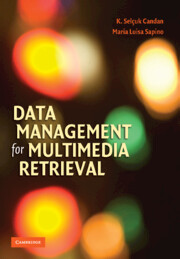Book contents
- Frontmatter
- Contents
- Preface
- 1 Introduction: Multimedia Applications and Data Management Requirements
- 2 Models for Multimedia Data
- 3 Common Representations of Multimedia Features
- 4 Feature Quality and Independence: Why and How?
- 5 Indexing, Search, and Retrieval of Sequences
- 6 Indexing, Search, and Retrieval of Graphs and Trees
- 7 Indexing, Search, and Retrieval of Vectors
- 8 Clustering Techniques
- 9 Classification
- 10 Ranked Retrieval
- 11 Evaluation of Retrieval
- 12 User Relevance Feedback and Collaborative Filtering
- Bibliography
- Index
- Plate section
6 - Indexing, Search, and Retrieval of Graphs and Trees
Published online by Cambridge University Press: 05 July 2014
- Frontmatter
- Contents
- Preface
- 1 Introduction: Multimedia Applications and Data Management Requirements
- 2 Models for Multimedia Data
- 3 Common Representations of Multimedia Features
- 4 Feature Quality and Independence: Why and How?
- 5 Indexing, Search, and Retrieval of Sequences
- 6 Indexing, Search, and Retrieval of Graphs and Trees
- 7 Indexing, Search, and Retrieval of Vectors
- 8 Clustering Techniques
- 9 Classification
- 10 Ranked Retrieval
- 11 Evaluation of Retrieval
- 12 User Relevance Feedback and Collaborative Filtering
- Bibliography
- Index
- Plate section
Summary
In Chapter 2, we have seen that most high-level multimedia data models (especially those that involve representation of spatiotemporal information, object hierarchies – such as X3D – or links – such as the Web) require tree or graph-based modeling. Therefore, similarity-based retrieval and classification commonly involve matching trees and graphs.
In this chapter, we discuss tree and graph matching. We see that, unlike the case with sequences, computing edit distance for finding matches may be extremely complex (NP-hard) when dealing with graphs and trees. Therefore, filtering techniques that can help prune the set of candidates are especially important when dealing with tree and graph data.
GRAPH MATCHING
Although, as we discussed in Section 3.3.2, graph matching through edit distance computation is an expensive task, there are various heuristics that have been developed to perform this operation efficiently. In the rest of this section, we consider three heuristics, GraphGrep, graph histograms, and graph probes, for matching graphs.
6.1.1 GraphGrep
Because the graph-matching problem is generally very expensive, there are various heuristics that have been developed for efficient matching and indexing of graphs. GraphGrep [Giugno and Shasha, 2002] is one such technique, relying on a path-based representation of graphs.
GraphGrep takes an undirected, node-labeled graph and, for each node in the graph, finds all paths that start at this node and have length up to a given, small upper bound, lp.
- Type
- Chapter
- Information
- Data Management for Multimedia Retrieval , pp. 208 - 234Publisher: Cambridge University PressPrint publication year: 2010

